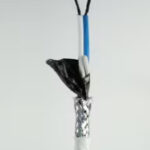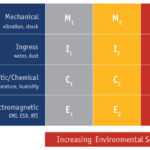MIL-SPEC connectors are designed to operate reliably in challenging conditions and extreme environments. First developed in the 1930s for the US Armed Forces, military standard connectors are now used across multiple industries, from energy and aerospace to maritime and automotive. This article discusses key MIL-SPEC connector design requirements and reviews crucial connector selection criteria. It also highlights some of the most popular MIL-SPEC connectors, such as MIL-C-5015, MIL-C-26500 (Figure 1), and MIL-DTL-5015.

Determining MIL-SPEC connector design requirements
MIL-SPEC standards specify various connector form factors and designs, such as circular, cylindrical, rectangular, and D-sub. These connectors typically comprise a mating pair, facilitating secure and reliable connections through aligned pin and socket contacts. MIL-SPEC connectors are generally manufactured with alloys such as phosphor-bronze, beryllium-copper, aluminum, or stainless steel. They may also include components made from ceramics and high-performance polymers, all plated or coated with conductive, non-corrosive metals such as nickel or gold. Notably, MIL-SPEC fiber connectors incorporate ferrules — small cylindrical components — to precisely align and secure fibers.
All MIL-SPEC connectors adhere to US Department of Defense (DoD) guidelines mandating robust physical durability and stringent signal integrity requirements. Some connectors, for example, must operate effectively in extreme temperatures, ranging from -85°F (-65°C) to 347°F (175°C). MIL-SPEC connector guidelines also address mitigation and resistance to electromagnetic interference (EMI), radio frequency interference (RFI), and electrostatic discharge (ESD) with specialized filters, shielding, and materials. Additionally, MIL-SPEC standards for specialized connectors cover crucial features such as fireproofing and waterproofing, hermetic sealing, vibration resistance, and even lightning-strike survivability.
Designing and selecting MIL-SPEC connectors requires a detailed analysis of application and mission parameters, along with a thorough review of technical specifications such as contacts, terminals, coupling mechanisms, and protective shells.
Optimizing connection integrity with contacts and terminals
The size and number of contacts in MIL-SPEC connectors directly impact electrical pathway strength and signal integrity. Numerous small contacts, for example, can support a broad spectrum of signals and power connections for avionics control systems and advanced communications gear. Larger and fewer contacts can streamline disconnection, reconnection, and in-field upgrades for vehicle-mounted electronics and rugged field communication or tracking systems (Figure 2).

Various MIL-SPEC terminal configurations and techniques help ensure optimal electrical and mechanical performance for different contact sizes and counts. These encompass simple screws, lugs, and cage clamps, as well as more advanced options such as solder cups, through-hole technology (THT), and insulation displacement connectors (IDCs) for efficient mass termination. Manufacturers may also use specialized tools to wrap wire around terminal posts for reliable, solder-free links.
MIL-SPEC connectors fitted with solder cups achieve robust, secure, and permanent connections, crucial for high-reliability aerospace systems. MIL-SPEC connectors containing IDCs enable rapid configuration and real-time adjustments without specialized tools, an essential feature for in-field communication systems. Similarly, MIL-SPEC connectors with THT terminals provide durable mechanical and electrical connections while effectively resisting vibrations and harsh environmental conditions, a prerequisite for ground vehicle electronic systems. Lastly, MIL-SPEC connector screw and lug terminals streamline testing and inspections for military electronic components such as power distribution modules.
Securing MIL-SPEC connectors with couplers and protective shells
To support mission-specific applications safely and efficiently, MIL-SPEC connectors can be fitted with one of the following coupling mechanisms:
- Threaded: Providing robust and secure engagement, vibration-resistant threaded couplers are used in ground vehicles and aviation system MIL-SPEC connectors.
- Bayonet: Offering rapid engagement and disengagement, bayonet couplers target field radios, handheld communication devices, tactical gear, weapon systems, and vehicle-mounted electronics. With their easy-to-use, reliable connector locking mechanisms, bayonet couplers facilitate efficient setup, maintenance, and reconfiguration in various military operations.
- Breech lock: Featuring removable locking rings, breech lock couplers secure MIL-SPEC connectors in high-reliability applications requiring frequent assembly and disassembly, such as aerospace maintenance, combat field operations, and other mission-critical military environments.
- Ball detent: Withstanding impact without disengaging, ball detent couplers include self-locking, push-pull mechanisms. These couplers are a popular choice for MIL-SPEC connectors used in portable, in-field military devices and equipment.
To bolster durability, MIL-SPEC connectors often feature protective shells made from corrosion-resistant materials such as anodized or plated aluminum. Accommodating various configurations and mounting requirements with different sizes and form factors, these shells seamlessly integrate with backshells to further bolster strain relief and environmental sealing (Figure 3).

Designed to align with shell housings, straight or angled plugs ensure proper orientation and secure connections in compact spaces such as avionic control panels or handheld communication devices. Similarly, in-line or cable receptacles facilitate flexible cable management for space-constrained mobile equipment and vehicles. Lastly, wall or box-mount receptacles securely integrate with shell housings, maintaining reliable connection points for stationary systems.
Exploring MIL-SPEC connectors
MIL-SPEC connectors play a crucial role in many military platforms and systems, from aircraft and ships to ground vehicles and communications. MIL-C-26500 miniature circular connectors, for example, support advanced missiles, rockets, aircraft, and space vehicles, while MIL-DTL-5015 rear-release connectors target airframes and ground support equipment. Compact MIL-C-26482 connectors are widely used in military communication systems, and MIL-C-24321D connectors, which pair gold-plated contacts with hermetically sealed caps, offer high levels of corrosion resistance and hydrostatic pressure resistance for naval vessels. Additional key MIL-SPEC connectors include:
- MIL-C-27599 and MIL-C-38999: Targeting crucial avionics and communication systems, MIL-C-27599 and MIL-C-38999 connectors pack high-density, environmentally resistant interfaces with bayonet couplings for operating temperatures ranging from -65°C to 175°C.
- MIL-C-81703: Featuring miniature circular designs with both solder and removable crimp contacts, the compact and environmentally resistant MIL-C-81703 connector supports avionics systems, military communication equipment, and various electronic instruments.
- MIL-DTL-32139, MIL-DTL-38999, MIL-DTL-83513, and MIL-DTL-83723: Spanning broad requirements, these connectors range from nano-miniature to environmentally resistant circular designs, each meeting mission-specific operational requirements in various temperature and environmental conditions.
- MIL-C-5015 and MIL-C-22992: Supporting heavy-duty military applications such as ground vehicles and power distribution systems, MIL-C-5015 connectors provide robust, reliable connections despite vibrations and mechanical stress, while MIL-C-22992 connectors offer large, rugged interfaces for high-power applications and extreme outdoor conditions.
Summary
Designed for challenging conditions and extreme environments, MIL-SPEC connectors target a broad spectrum of mission-specific applications across aircraft, ships, ground vehicles, and communications systems. Although MIL-SPEC standards cover various form factors and materials, all connectors adhere to US DoD guidelines that mandate robust physical durability and stringent signal integrity requirements. Design and selection of MIL-SPEC connectors typically involve a meticulous analysis of application and mission parameters, alongside a thorough review of key technical specifications such as contacts, terminals, coupling mechanisms, and protective shells.
References
What Are Mil-Spec Connectors?, Rowse
Key Considerations in Selecting Military-Style Connectors, Amerline|
Examining Connector Specifications in Aerospace and Military
Applications, SATPlating
The Ultimate Guide to Military Connectors, MocoConnectors
Putting It Together – Everything You Need to Know About Military Connector Types, SealTron
Military (MIL-SPEC) Connectors Information, GlobalSpec






Leave a Reply
You must be logged in to post a comment.